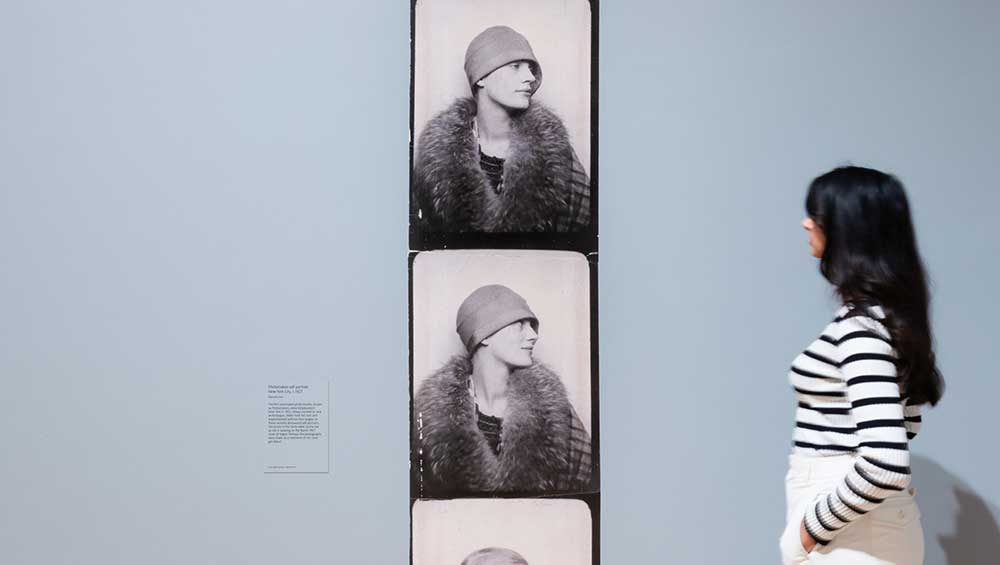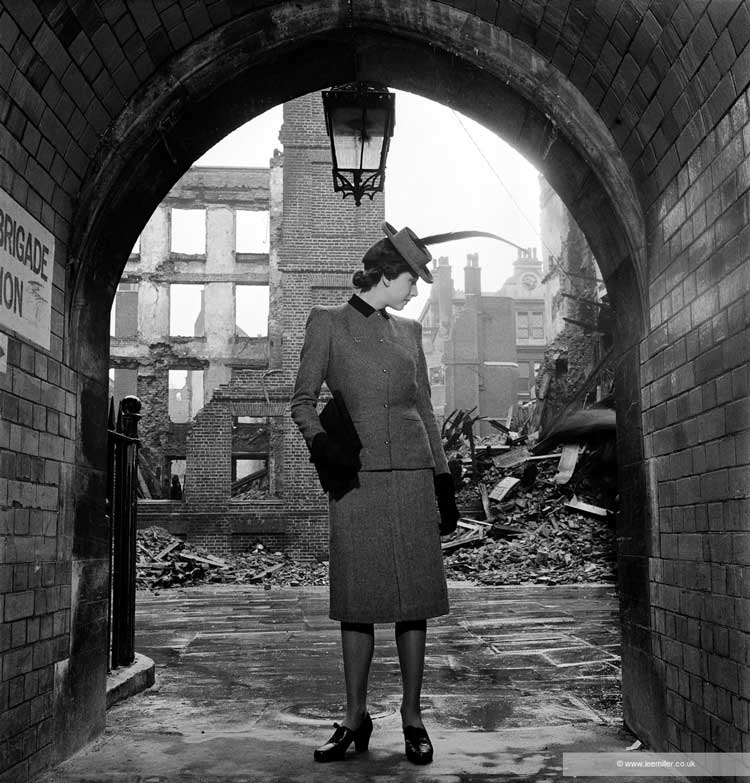
Lee Miller, installation view, Tate Britain, 2 October 2025 – 15 February 2026. © Lee Miller Archives, England 2025. All rights reserved. leemiller.co.uk. Photo: © Tate (Sonal Bakrania).
Tate Britain, London
2 October 2025 – 15 February 2026
by SABINE SCHERECK
The exhibition is simply called Lee Miller and billed as the “most extensive retrospective yet staged in the UK”. Is this underselling what awaits the visitor, who might have come across Miller (1907-77) only as a muse for 1930s Vogue photographers or through her courageous work as a war photographer, the latter of which was the subject of the 2023 film Lee? The show at Tate Britain opens up a window to the many worlds she inhabited and gives a sense of the strong, fearless and driven, but also witty woman she was. Looking behind the images reveals a spirit who loved adventure, embraced life and sought to see it with different eyes. She was clearly a pioneer and is still an inspiration today. By unfolding the breadth of her work, the retrospective offers a bigger picture rather than just one facet of her output, which has been the case with previous exhibitions.
The show traces her development largely chronologically, starting from when she left her first professional mark as a model in New York aged 19. The introductory wall text shows a Vogue cover from 1927 featuring Lee in a colour illustration by George Lepape. The text points out that she embodied the ideals of the period: a boyish, youthful and androgynous beauty. On top of that, she had the personality to match, for example shortening her name from Elizabeth to Lee. She was exactly what a fashion magazine needed.
-Lee-Miller-Archives,-England-2025-All-rights-reserved.jpg)
Lee Miller, Portrait of Space, Al Bulwayeb near Siwa, 1937. Lee Miller Archives. © Lee Miller Archives, England 2025. All rights reserved. leemiller.co.uk.
A great find is an enlarged strip from a photo booth from 1927, in which she poses with the same cloche hat that she wears on the Vogue cover in March that year. Quintessentially, these shots are self-portraits and document how she experimented with staging herself and taking control of her image – she is not just the model, but the mastermind behind the image. The section features several self-portraits, which are made in the classic style of the great fashion photographers of the time, Edward Steichen and George Hoyningen-Huene. Photographs of Miller by the two men are also included in the first section. The timeless beauty of their portraits of her stuck out in two exhibitions in Berlin last year, Chronorama: Photographic Treasures of the 20th Century and George Hoyningen-Huene – Glamour & Style. At Tate Britain, I re-encounter Hoyningen-Huene’s modern masterpiece, Lee Miller, Sailcloth Overalls by Yrande (1930), which could have come off the press yesterday.
Even before Miller earned money from modelling, the camera had been a constant presence in her life as her father was a keen amateur photographer. Questions of staging a subject also occupied her when she moved to Paris in 1925, aged 18, to study theatre design and the following year when she returned to the US to train in theatre lighting and dance. She also attended the Art Students League of New York in Manhattan. However, it was her collaboration with Steichen that set her on the path to becoming a photographer herself. To do so, she took a ship back to Paris in 1929 and was apprenticed to Man Ray, a fellow American, who had settled in Paris in 1921 and made a name for himself as an avant-garde photographer.

Lee Miller, Model with Lightbulb, c1943. Lee Miller Archives. © Lee Miller Archives, England 2025. All rights reserved. leemiller.co.uk.
They became lovers and their collaboration is illustrated in the second section displaying their surrealist and experimental work, including the artistic use of the solarisation effect in photography (where the negative is briefly exposed to light), which until now has been solely attributed to him. She also honed her craft beyond Ray’s studio walls and worked with Hoyningen-Huene. At the same time she captured motifs from the street such as architecture, railings, plants and shadows and gave them a surreal touch by choosing unusual angles and frames. Miller quickly became an artist in her own right and opened a studio in Paris. Her work also gained attention in photographic circles and was published and exhibited in major cities, including Paris, Brussels, Milan, London, New York and San Francisco. Less known is the fact that she worked as a medical photographer, documenting surgical procedures, testament to the fact that she did not lead a life for the faint-hearted. This work, too, would have prepared her for the horrific sights she faced during the war.

Lee Miller, You will not lunch in Charlotte Street today, London, 1940. Lee Miller Archives. © Lee Miller Archives, England 2025. All rights reserved. leemiller.co.uk.
After three whirlwind years in Paris, she returned to New York, but the Great Depression made it hard to keep up her newly acquired studio. She left all this behind in 1934 when she married an Egyptian businessman and moved to Cairo. Without the pressure of having to generate an income, she was able to explore Egypt and its surroundings, including Palestine, Syria, Greece and Romania. This forms the most interesting part of the retrospective as it presents images that have not been exhibited before. Here, too, plants, architecture – such as Untitled (Domes of the Monastery of Saint Mary El Sourian), Wadi Natrun (1939) – and the interaction between mankind and nature led to quirky sights that prompted her to pick up the camera.
Before rolling into the war years, the exhibition slots in portraits Lee made of friends and artists. They cover a wide range of styles: some are minimalistic with the sitter in front of a plain background, yet with a tweak that breaks with the tradition of creating a classic beauty portrait by leaving the edge of the white backdrop in the frame. Others show a sense of humour in their composition. Common to most is that they are staged and clearly original.

Lee Miller, Model Elizabeth Cowell wearing Digby Morton suit, London, 1941. Lee Miller Archives. © Lee Miller Archives, England 2025. All rights reserved. leemiller.co.uk.
In 1939, she relocated to London to be with the British surrealist artist Roland Penrose, whom she had met two years earlier in Europe. In London, she created much of her prominent work for British Vogue, first by placing fashion in wartime London after the blitz, then by portraying women at work within the war effort. Two pictures, both of fellow American female war correspondents, stand out: one of the writer Martha Gellhorn looking calmly at the viewer as she sits at a dressing table that serves as a desk and the other of photographer Margaret Bourke-White, who poses in uniform, smiling with her camera in her hands, under an aeroplane. Miller then ventured further into the war by becoming accredited to enter war zones alongside fighting soldiers, surrounded by gunfire and exploding bombs. Her images from the fields and the field hospitals do not shy away from the grim reality. This also applies to the harrowing finds she made in the concentration camps in Buchenwald and Dachau, which are in a room aside from the route that takes the visitor through the retrospective, which also includes the image of Miller in a bathtub in Adolf Hitler’s apartment in Munich, photographed by David E Scherman in 1945.
While her war images are an unflinching documentation of devastation and destruction, it is her pictures of the aftermath that have a soul and are the strongest. They show the tragedy left behind by the war across Europe, often marking the sorrow and melancholy of those who had to carve out a new life for themselves amid the bleak, flattened cityscape, or found themselves on the road after being expelled from their homes. The photographs are predominantly of women and children. Particularly memorable are: Cologne Cathedral (1945); Two German Women Sitting on a Park Bench Surrounded by Destroyed Buildings, Cologne (1945); and Bullet-Splintered Glass in a Café: Mlle Christiane Poignet, Law Student, Paris (1944). The picture of Cologne Cathedral is highly symbolic: taken from the inside, it depicts the grandeur of this architectural masterpiece with the clear lines of its pillars reaching high and emanating strength, yet the shattered glass windows and the rubble covering the floor almost to waist-height illustrate how a once powerful and majestic presence had fallen into pieces. It is a pitiful sight but also suggests humility. The two women also offer a bizarre sight: sitting on a bench that is still intact, while the surrounding homes are in ruins. The bench is not a place from which you would enjoy a pleasant view, yet the women with their winter coats and tousled hair look wistfully into the distance, somehow detached from their environment. The image of the young woman sitting in a cafe at a table by the window is equally striking. There is a certain calmness in such an everyday activity, yet her stern, slightly angry gaze into the distance and the bullet holes in the windows tell a different story – that of (past) danger and upheaval. What makes these images so remarkable is the juxtaposition between the subjects and their surroundings. Further images from this series demonstrate her compassion.
After the war, Miller continued to photograph for British Vogue until 1953 and then withdrew from the business, which deemed her too frivolous. In addition, the experiences of the war had taken a toll on her mental and physical health. By then married to Penrose and with a son, she retreated at the weekends to Farleys House in Sussex, which the couple had bought in 1949. She took few photographs, and those mainly private ones of friends and artists, including Pablo Picasso and Henry Moore, at home or during a trip to the US. These images make up the last room, which also gives a peek into her private life, noting that she had found joy in cooking, gained a reputation as a gourmet chef and welcomed guests as Farleys became a meeting place for her artistic circle.
Miller was modest about her work and only after her death was its true extent was discovered. For this retrospective, the curators, Hilary Floe and Saskia Flower, gathered about 230 images to put the spotlight on her artistic work, which tends to be overshadowed by her remarkable life. Charting her imagery through the decades, it becomes clear how strongly the surrealist art of her early years in Paris determined her perception of the world. It also reflects the humour and absurdity she saw in life and hints at her sharp mind. This leads me to wish the exhibition had provided more information about her, so as to get a better sense of the witty, energetic and extraordinary character she was. Details such as the sexual abuse she experienced as a child by a friend of the family are kept in the exhibition catalogue, although a note on a wall text that her father photographed her nude as a child suggests there was something disturbing in her past. On a brighter note, however, during their five-year-long research for the show, the curators discovered that it was Vogue’s publisher, Condé Nast, who, recognising Lee’s potential, recommended that Hoyningen-Huene train her as a photographer while she was in Paris. All this piques the curiosity to learn more about the woman behind this vast oeuvre.
• The retrospective will also be on show at the Musée d’Art Moderne de Paris, from 3 April to 26 July 2026.